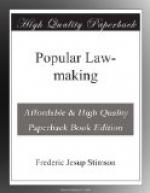(1550) In the 3d of Edward VI we find the first Riot Act, aimed at persons to the number of twelve or above assembling together and proposing to alter the laws and not dispersing when so required by the sheriff, and even persons more than two and less than twelve assembling for such purpose are subject to fine and imprisonment with treble damages to parties injured, and if forty persons so assemble and do not disperse in three hours, they are declared felons. This statute was re-enacted and made more severe in the reign of Queen Mary.
(1562) In the 5th of Elizabeth comes the last and greatest Statute of Laborers. This statute is a consolidation of all previous laws, and it begins by recognizing the principle that the fixing of wages is a mistake and all such laws are repealed so far as they relate to terms of hiring and wages. Servants in certain employments, generally speaking the tailoring and shoemaking trades, may still be hired by the year, and persons unmarried, not having an income of forty shillings a year, may be compelled to serve in their own handicraft. Such yearly servants may not be dismissed or depart during the year except by cause allowed by two justices, nor at the end of a year, without a quarter’s warning. Unmarried persons under thirty, not having any trade and not belonging to a nobleman’s household, may be compelled to labor at the request of any person using an art or mystery, and all persons between twelve and sixty not otherwise employed may be compelled




